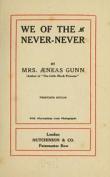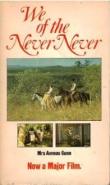AustLit
Latest Issues
AbstractHistoryArchive Description
In 1902 Jeannie Gunn, a Melbourne schoolteacher, went with her new husband to live on the remote Elsey cattle station near the Roper River in the Northern Territory. Although she spent little more than a year there, her experiences in the outback and her contact with the local Aboriginal people impressed her deeply, and on her return to Melbourne she set down her recollections in two books, We of the Never Never and The Little Black Princess.
Adaptations
-
form
y
 We of the Never Never
( dir. Igor Auzins
)
Australia
:
Adams Packer Film Productions
,
1982
Z901254
1982
single work
film/TV
(taught in 6 units)
We of the Never Never
( dir. Igor Auzins
)
Australia
:
Adams Packer Film Productions
,
1982
Z901254
1982
single work
film/TV
(taught in 6 units)
Based on Jeannie Gunn's fictionalised autobiography of the same name, the story begins in 1902 with the arrival of Mrs Gunn and her new husband Aeneas in the Northern Territory. They have come to take over management of Elsey Station, a huge cattle and horse property. She is subsequently forced to battle isolation, disease, and the white stockmen who believe the station is no place for a woman. She befriends the local Aboriginal women, but is mystified by their culture. Her affection for the place and the people is tested by frequent tragedy.
(Source: Australian Screen.)
Notes
-
The author called this a novel. It is, however, autobiographical.
-
The book was rejected by six publishers in three months, but when it was published it became immensely popular and has been republished numerous times in Australia and the UK as well as in translation, reaching its 28th 'edition' in the 1930s.
-
Has been adapted for use in schools.
-
Harold White, in a letter dated 5 November 1953 to H. M. Green (held in the Dorothy Green Manuscript Collection at the Academy Library UNSW Canberra) advised Green that the novel is classified as fiction by the Commonwealth National Library, 'as the first edition bears the subtitle "a novel"'. White adds that 'Morris Miller also lists it as fiction, although he adds the proviso that it is not really a novel'.
Source: H. L. White, [Letter to H. M Green, Dated 5 November 1953], Dorothy Green and H. M. Green, Dorothy Green Manuscript Collection (1918-1990)
-
Dedication: Dedicated to 'The Bush-Folk of the Never-Never'
Publication Details of Only Known VersionEarliest 2 Known Versions of
Other Formats
- Also braille and sound recording.
Works about this Work
-
Australian Women Writers’ Popular Non-fiction Prose in the Pre-war Period : Exploring Their Motivations
2022
single work
criticism
— Appears in: The Australasian Journal of Popular Culture , vol. 11 no. 1-2 2022; (p. 63-80) 'Since the 1970s, feminist scholars have undertaken important critical work on Australian women’s writing of earlier eras, profiling and promoting their fiction. Less attention has been afforded to the popular non-fiction produced by Australian women writers and, in particular, to that produced before the Second World War. Yet this writing is important for several reasons. First, the non-fiction writing of Australian women was voluminous and popular with readers. Second, this popular work critically engaged with a tumultuous political, social and moral landscape in which, as women’s rights were increasingly realized through legislation, the subjectivity of women themselves was fluid and contested. Third, as many of these women were also, or principally, fiction writers, their non-fiction can be shown to have informed and influenced many of their fictional interests, themes and characters. Lastly, and critically, popular non-fiction publication helped to financially sustain many of these writers. In proposing a conceptual framework informed by the work of Pierre Bourdieu to analyse examples of this body of work, this article not only suggests that important connections exist between popular and mainstream non-fiction works – newspaper and magazine articles, essays, pamphlets and speeches – and the fictional publications of Australian women writers of the early twentieth century but also suggests that these connections may represent an Australian literary habitus where writing across genre, form and audience was a professional approach that built and sustained literary careers.' (Publication abstract) -
‘A Flicker of the Divine Progress?’ : Stage-managing Narratives of Empire in Jan Morris's Pax Britannica Trilogy
2022
single work
criticism
— Appears in: Textual Practice , August vol. 36 no. 8 2022; (p. 1-20)'When Jan Morris died in 2020, people from around the world praised her elegant and eloquent writing, and her extraordinary life. Her many achievements included the publication between 1966 and 1978 of the ‘intellectual and artistic high-point of [her] career’: the Pax Britannica trilogy charting the zenith and decline of the British Empire. The popular trilogy, which remains in print, played a key role in establishing the late twentieth-century cultural narrative that the British Empire was ‘a force for good’ in the world. Calling into question the boundary between history, fiction and memory, Morris draws heavily on theatrical techniques to both construct a narrative of Empire, one which is dominated by the adventures of individual imperialists, and draw attention to its fabrication. Attending closely to its mode of address, I argue that Morris's trilogy, while equivocal and, in places, critical, ultimately offers a reassuring narrative of Empire. At a time of debate about these histories, I argue that the memorialising of Morris in the wake of her death represents one example of a continuing refusal to face the ongoing consequences of Empire.'(Publication abstract)
-
Forbidding Treasure
2015
single work
column
— Appears in: The Weekend Australian , 7-8 March 2015; (p. 6-8)Western fascination with the north Kimberley coastline has endured since seafarers encountered it in the 17th century, writes Nicholas Rothwell.
-
Books That Changed Me : Jessica Owers
2013
single work
column
— Appears in: The Sun-Herald , 10 November 2013; (p. 12) -
Wild Love
2013
single work
column
— Appears in: The Weekend Australian , 26-27 October 2013; (p. 9) 'Jeannie Gunn's classic book We of the Never Never is the great-grandmother of the booming rural romance genre, argues Jessica Owers.'
-
Twelve Australian Books That Should Be in Every Australian Home
1937
single work
review
— Appears in: All About Books , 10 November vol. 9 no. 11 1937; (p. 172)
— Review of The Singing Gold 1927 single work novel ; Landtakers : The Story of an Epoch 1934 single work novel ; Confessions of a Beachcomber 1908 extract autobiography ; The Sentimental Bloke : The Play 1914 single work poetry ; Songs of a Campaign 1917 selected work poetry ; Heart of Spring 1919 selected work poetry ; Satyrs and Sunlight : Being the Collected Poetry of Hugh McCrae 1928 selected work poetry ; His Natural Life 1870-1872 single work novel ; The Pearl and the Octopus, and Other Exercises in Prose and Verse 1911 selected work short story poetry ; Such Is Life : Being Certain Extracts from the Diary of Tom Collins 1897 single work novel ; Flynn of the Inland 1932 single work biography ; The Fortunes of Richard Mahony 1917 single work novel ; Man-Shy 1934 extract novel ; We of the Never-Never 1908 single work novel ; Speaking Personally 1930 selected work essay ; Best Australian One-Act Plays 1937 anthology drama ; The Wide Brown Land : A New Anthology of Australian Verse 1934 anthology poetry ; The Magic Pudding Second Slice : Being the Adventures of Bunyip Bluegum and His Friends Bill Barnacle and Sam Sawnoff 1971 extract children's fiction ; Separate Lives 1931 selected work short story ; Modern Australian Literature, 1900-1923 1924 single work criticism -
Mrs Aeneas Gunn
1927
single work
review
— Appears in: The Home , 1 October vol. 8 no. 10 1927; (p. 107)
— Review of We of the Never-Never 1908 single work novel ; The Little Black Princess : A True Tale of Life in the Never-Never Land 1905 single work autobiography -
The Far North in Books : No. 6 : We of the Never Never
1931
single work
review
— Appears in: Northern Affairs , 4 December vol. 1 no. 8 1931; (p. 19)
— Review of We of the Never-Never 1908 single work novel -
[Review] We of the Never-Never
1945
single work
review
— Appears in: Southerly , vol. 6 no. 2 1945; (p. 13-14)
— Review of We of the Never-Never 1908 single work novel -
Timely Reissue
1982
single work
review
— Appears in: The Canberra Times , 30 October 1982; (p. 13)
— Review of We of the Never-Never 1908 single work novel -
Lawson, Gunn and the 'White Chinaman': A Look at How Chinese are Made White in Henry Lawson and Mrs Aeneas Gunn's Writings
2003
single work
criticism
— Appears in: LiNQ , October vol. 30 no. 2 2003; (p. 10-23) -
Jack London and the Never Never
2004
single work
criticism
— Appears in: Overland , Summer no. 177 2004; (p. 88-89)In 1910 Jack London wrote an introduction for a proposed American edition of We of the Never Never but it was never published. The manuscript, in Jeannie Gunn's handwriting, is contained in a book of letters written to William Peter Hurst and the location is:- MS 6107, Box 169/1. William Peter Hurst papers. La Trobe Australian Manuscripts Collection, State Library of Victoria.
The 'preface', as it was later described by Mrs Gunn, has been reproduced in this article.
-
'They Will Have to Come Sooner or Later if You Stick At 'Em : Horse Breaking As Metaphor in Australian Cultural Discourse
2005
single work
criticism
— Appears in: Westerly , November vol. 50 no. 2005; (p. 226-234) Contends that 'horse breaking' has been used in Australian literature as a euphamism and 'justification' for Aboriginal-white conflict and dispossession of Aboriginal land. -
Jeannie Gunn's Tree in the Never-Never
1954
single work
correspondence
— Appears in: Walkabout , vol. 20 no. 2 1954; (p. 45) -
What Ten Books Would You Take?
1929
single work
criticism
— Appears in: All About Books , 20 May vol. 1 no. 6 1929; (p. 187) Reviewer Nuttall lists ten books she would take to an isolated island of which three are by Australian authors.
- Roper River area, East Arnhem Land, Arnhem Land, Top End, Northern Territory,
- Bush,
- 1902




